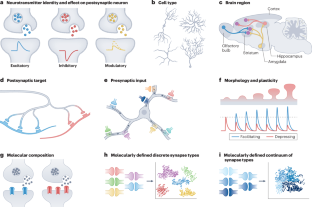了解突触的分子多样性
IF 28.7
1区 医学
Q1 NEUROSCIENCES
引用次数: 0
摘要
突触由数千种蛋白质组成,提供了广泛的分子多样性来塑造突触类型特异性功能特化的潜力。在这篇综述中,我们探讨了突触多样性的景观,并描述了扩大突触分子复杂性的机制,从基因型到基因表达的调控,到特定蛋白质形态的产生和局部蛋白质复合物的形成。我们强调检查每个分子层的重要性,并采用系统的观点来理解这些相互关联的机制如何塑造突触的各种功能和结构特性。我们探索当前的框架分类突触和方法,以研究不同规模的不同突触类型,从突触类型特异性蛋白质组学到先进的成像技术与单突触分辨率。我们强调了突触类型特异性方法的潜力,将分子数据与细胞功能、电路组织和生物体表型相结合,从而能够在不同尺度上对神经元现象进行更全面的探索。本文章由计算机程序翻译,如有差异,请以英文原文为准。


Understanding the molecular diversity of synapses
Synapses are composed of thousands of proteins, providing the potential for extensive molecular diversity to shape synapse type-specific functional specializations. In this Review, we explore the landscape of synaptic diversity and describe the mechanisms that expand the molecular complexity of synapses, from the genotype to the regulation of gene expression to the production of specific proteoforms and the formation of localized protein complexes. We emphasize the importance of examining every molecular layer and adopting a systems perspective to understand how these interconnected mechanisms shape the diverse functional and structural properties of synapses. We explore current frameworks for classifying synapses and methodologies for investigating different synapse types at varying scales, from synapse-type-specific proteomics to advanced imaging techniques with single-synapse resolution. We highlight the potential of synapse-type-specific approaches for integrating molecular data with cellular functions, circuit organization and organismal phenotypes to enable a more holistic exploration of neuronal phenomena across different scales. The set of proteins present at synapses determines their heterogeneous functions and properties. In this Review, van Oostrum and Schuman describe the molecular mechanisms that contribute to the diversity of the synaptic proteome and consider how this molecular complexity can be captured by approaches for synapse classification.
求助全文
通过发布文献求助,成功后即可免费获取论文全文。
去求助
来源期刊

Nature Reviews Neuroscience
NEUROSCIENCES-
自引率
0.60%
发文量
104
期刊介绍:
Nature Reviews Neuroscience is a multidisciplinary journal that covers various fields within neuroscience, aiming to offer a comprehensive understanding of the structure and function of the central nervous system. Advances in molecular, developmental, and cognitive neuroscience, facilitated by powerful experimental techniques and theoretical approaches, have made enduring neurobiological questions more accessible. Nature Reviews Neuroscience serves as a reliable and accessible resource, addressing the breadth and depth of modern neuroscience. It acts as an authoritative and engaging reference for scientists interested in all aspects of neuroscience.
 求助内容:
求助内容: 应助结果提醒方式:
应助结果提醒方式:


